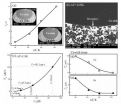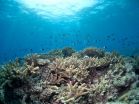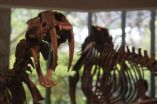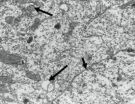(Press-News.org) Philadelphia, PA, April 10, 2014 – Two new studies published this week in Biological Psychiatry shed light on the propensity for habit formation in obsessive-compulsive disorder (OCD). These studies suggest that a tendency to develop habits, i.e., the compulsive component of the disorder, may be a core feature of the disorder rather than a consequence of irrational beliefs. In other words, instead of washing one's hands because of the belief that they are contaminated, some people may develop concerns about hand contamination as a consequence of a recurring urge to wash their hands.
Habits are behaviors engrained by practice that enable us to perform very complex behaviors in a nearly automatic way, such as swinging a golf club or performing a piano sonata. Habits do not seem to be fully conscious goal-directed behaviors in that when one thinks about the details of the complex behavior, for example when trying to improve a golf swing, it often interferes with the expression of the habit.
Habits also appear to be defining characteristics of psychiatric disorders with prominent behavioral components, such as alcoholism, drug addiction, pathological gambling, and eating disorders. These new studies support the view that habit formation is also an important component of OCD.
Both studies were conducted by researchers at the University of Cambridge who compared habits and goal-directed behaviors in a group of people diagnosed with OCD and a matched group of healthy people. They found that the group with OCD had a greater tendency to develop avoidance habits and also displayed impairments of their goal-directed decision making.
"Habit formation is appearing to be a critical component of an increasing number of illnesses including eating disorders, addictions, and now OCD," commented Dr. John Krystal, Editor of Biological Psychiatry. "For all of these conditions, we need to better understand the biology of habit formation to rationally develop new and more effective treatments."
"The bigger picture from these studies is that we have identified a model of compulsivity, which may extend beyond OCD and prove to be a good model of how people lose control over their own behavior more generally, and in other disorders of compulsivity, like addiction and some eating disorders," said Dr. Claire Gillan, corresponding author on both projects.
"Importantly, this model was derived from earlier work in both animals and humans which characterized dissociable neural systems supporting the balance between purposeful action and more automatic habits. The time is right for psychiatry to start moving away from diagnostic labels and instead focus of biological traits that transcend the current definitions of discrete disorders."
It is hoped that a greater level of biological precision will allow for the development of targeted treatments for individuals, and hopefully allow movement away from a one-size-fits-all approach to treatment. These studies are a step in this direction.
INFORMATION:
The articles are "Enhanced Avoidance Habits in Obsessive-Compulsive Disorder" by Claire M. Gillan, Sharon Morein-Zamir, Gonzalo P. Urcelay, Akeem Sule, Valerie Voon, Annemieke M. Apergis-Schoute, Naomi A. Fineberg, Barbara J. Sahakian, and Trevor W. Robbins (DOI: 10.1016/ j.biopsych.2013.02.002) and "Counterfactual Processing of Economic Action-Outcome Alternatives in Obsessive-Compulsive Disorder: Further Evidence of Impaired Goal-Directed Behavior" by Claire M. Gillan, Sharon Morein-Zamir, Muzaffer Kaser, Naomi A. Fineberg, Akeem Sule, Barbara J. Sahakian, Rudolf N. Cardinal, and Trevor W. Robbins (DOI: 10.1016/j.biopsych.2013.01.018). The articles appear in Biological Psychiatry, Volume 75, Issue 8 (April 15, 2014), published by Elsevier.
Notes for editors
Full text of the articles is available to credentialed journalists upon request; contact Rhiannon Bugno at +1 214 648 0880 or Biol.Psych@utsouthwestern.edu. Journalists wishing to interview the authors may contact Claire Gillan at +44 (0) 1223 76428 or claire.gillan@gmail.com.
The authors' affiliations, and disclosures of financial and conflicts of interests are available in the article.
John H. Krystal, M.D., is Chairman of the Department of Psychiatry at the Yale University School of Medicine, Chief of Psychiatry at Yale-New Haven Hospital, and a research psychiatrist at the VA Connecticut Healthcare System. His disclosures of financial and conflicts of interests are available here.
About Biological Psychiatry
Biological Psychiatry is the official journal of the Society of Biological Psychiatry, whose purpose is to promote excellence in scientific research and education in fields that investigate the nature, causes, mechanisms and treatments of disorders of thought, emotion, or behavior. In accord with this mission, this peer-reviewed, rapid-publication, international journal publishes both basic and clinical contributions from all disciplines and research areas relevant to the pathophysiology and treatment of major psychiatric disorders.
The journal publishes novel results of original research which represent an important new lead or significant impact on the field, particularly those addressing genetic and environmental risk factors, neural circuitry and neurochemistry, and important new therapeutic approaches. Reviews and commentaries that focus on topics of current research and interest are also encouraged.
Biological Psychiatry is one of the most selective and highly cited journals in the field of psychiatric neuroscience. It is ranked 4th out of 135 Psychiatry titles and 13th out of 251 Neurosciences titles in the Journal Citations Reports® published by Thomson Reuters. The 2012 Impact Factor score for Biological Psychiatry is 9.247.
About Elsevier
Elsevier is a world-leading provider of information solutions that enhance the performance of science, health, and technology professionals, empowering them to make better decisions, deliver better care, and sometimes make groundbreaking discoveries that advance the boundaries of knowledge and human progress. Elsevier provides web-based, digital solutions — among them ScienceDirect, Scopus, Elsevier Research Intelligence, and ClinicalKey — and publishes nearly 2,200 journals, including The Lancet and Cell, and over 25,000 book titles, including a number of iconic reference works.
The company is part of Reed Elsevier Group PLC, a world leading provider of professional information solutions in the Science, Medical, Legal and Risk and Business sectors, which is jointly owned by Reed Elsevier PLC and Reed Elsevier NV. The ticker symbols are REN (Euronext Amsterdam), REL (London Stock Exchange), RUK and ENL (New York Stock Exchange).
Media contact
Rhiannon Bugno
Editorial Office
+1 214 648 0880
Biol.Psych@utsouthwestern.edu
Obsessive-compulsive disorder may reflect a propensity for bad habits
Report new studies in Biological Psychiatry
2014-04-10
ELSE PRESS RELEASES FROM THIS DATE:
Solute redistribution profiles during rapid solidification of undercooled ternary Co-Cu-Pb alloy
2014-04-10
Researchers at the Department of Applied Physics, Northwestern Polytechnical University, in Xi'an, China, are engaged in revealing the mysteries of solidification process and the development of new materials using self-designed experimental instrument which can simulate the space environment such as containerless state. Solidification mechanism is of great importance to better understand the relationship between solidification process and microstructure evolution, so that we can follow them to design and prepare new materials which can meet the application requirements.
Dr. ...
New report provides solution to NEET challenge in UK and abroad
2014-04-10
A NEW strategy to help young people find jobs that pay fair wages, accompanied by high quality training and better career opportunities, has been developed by a University of Huddersfield professor. Outlined in a specially-commissioned research report, it is beginning to catch the attention of policy-makers throughout the UK.
After conducting years of funded research into the challenges that face young people dubbed NEET – meaning that they are not in employment, education or training – Professor Robin Simmons has devised the concept of a Youth Resolution designed to ...
Researchers show fruit flies have latent bioluminescence
2014-04-10
WORCESTER, Mass. – New research from scientists at the University of Massachusetts Medical School shows that fruit flies are secretly harboring the biochemistry needed to glow in the dark —otherwise known as bioluminescence.
The key to activating this latent ability is a novel synthetic analog of D-luciferin developed at UMMS. The findings, published in the journal Proceedings of the National Academy of Sciences, suggest that the inherent biochemistry needed for bioluminescence is more common than previously thought. Synthetic luciferins can unmask latent enzymatic ...
Coral reefs of the Mozambique Channel a leading candidate for saving marine diversity
2014-04-10
Marine scientists keen on finding patterns of coral decline and persistence in gradually warming oceans have a complex challenge: how to save reefs containing the most diversity with limited resources. In the Western Indian Ocean, researchers from the Wildlife Conservation Society, the University of Warwick, the ARC Centre for Excellence of Coral Reef Studies, Simon Fraser University, University of North Carolina at Chapel Hill, and other groups have found that the corals of the Mozambique Channel should be a priority for protection as climate change continues to threaten ...
Reef fish arrived in 2 waves
2014-04-10
The world's reefs are hotbeds of biological diversity, including over 4,500 species of fish. A new study shows that the ancestors of these fish colonized reefs in two distinct waves, before and after the mass extinction event about 66 million years ago that wiped out the dinosaurs.
Reef fish represent one of the largest and most diverse assemblages of vertebrates, according to Samantha Price, a postdoctoral researcher in the Department of Evolution and Ecology at UC Davis. Price is first author on a paper describing the work, published April 2 in the journal Proceedings ...
CU researchers unraveling what's behind the sniffles, hoping for a treatment
2014-04-10
Scientists at the University of Colorado School of Medicine have shed light on one of the most common of ailments – the runny nose.
Your respiratory tract is under constant attack and the nose is the first line of defense. Often, especially as the weather warms, the assault comes from allergens, which cause the body to fight off a perceived threat. Infections, too, are a problem.
But millions of people get a runny nose and have difficulty breathing without an allergic attack or infection. What many people call the sniffles, scientists refer to as "non-allergic rhinitis."
Although ...
China looks to science and technology to fuel its economy
2014-04-10
Maintaining stability in the face of rapid change and growth, and proactively partaking in cooperative global ties in science and technology fields will be key in helping China become an innovation-based economy, according to Denis Simon, vice provost for International Strategic Initiatives at Arizona State University.
One of the world's leading experts on science, technology and innovation in China, Simon recently hosted an ASU conference that focused on the evolving role of science and technology in China's international relations.
Supplemented with strategic investments ...
Researchers looking to create new bone tissue generation technique
2014-04-10
UT Arlington and Texas Health Arlington Memorial Hospital are investigating whether bone grown from the body's own stem cells can replace traditional types of bone grafting.
The process, which has been successful in previous lab experiments, uses biodegradable polymer scaffolding material and bone morphogenetic protein, or BMP, which was inserted into the abdomen of mice to attract stem cells that in turn produced bone. BMPs are proteins known to promote bone growth. The research is detailed in a new paper, "Tissue Engineering Bone Using Autologous Progenitor Cells in ...
La Brea Tar Pit fossil research shows climate change drove evolution of Ice Age predators
2014-04-10
LOS ANGELES — Concerns about climate change and its impact on the world around us are growing daily. New scientific studies at the La Brea Tar Pits are probing the link between climate warming and the evolution of Ice Age predators, attempting to predict how animals will respond to climate change today.
The La Brea Tar Pits are famous for the amazing array of Ice Age fossils found there, such as ground sloths, mammoths, and predators like saber-toothed cats and powerful dire wolves. But the climate during the end of the Ice Age (50,000-11,000 years ago) was unstable, ...
Acupuncture normalizes brain structure and damaged neurons following heroin relapse
2014-04-10
Heroin abuse can damage many brain areas, including the pedunculopontine tegmental nucleus of the midbrain, the ventral tegmental area, and nucleus accumbens. Persistent use of heroin induced irreversible damage to the nervous system. To verify the relationship between acupuncture, neurotrophic factor expression and brain cell structural changes, a research team from Anhui University of Chinese Medicine in China established a rat model of heroin relapse using intramuscular injection of increasing amounts of heroin. During the detoxification period, rat models received acupuncture ...
LAST 30 PRESS RELEASES:
Structure of dopamine-releasing neurons relates to the type of circuits they form for smell-processing
Reducing social isolation protects the brain in later life
Keeping the heart healthy increases longevity even after cancer
Young adults commonly mix cannabis with nicotine and tobacco
Comprehensive review illuminates tau protein's dual nature in brain health, disease, and emerging psychiatric connections
Book prepares K-12 leaders for the next public health crisis
Storms in the Southern Ocean mitigates global warming
Seals on the move: Research reveals key data for offshore development and international ecology
Sports injuries sustained during your period might be more severe
World's first successful 2 Tbit/s free-space optical communication using small optical terminals mountable on satellites and HAPS
Can intimate relationships affect your heart? New study says ‘yes’
Scalable and healable gradient textiles for multi‑scenario radiative cooling via bicomponent blow spinning
Research shows informed traders never let a good climate crisis go to waste
Intelligent XGBoost framework enhances asphalt pavement skid resistance assessment
Dual-function biomaterials for postoperative osteosarcoma: Tumor suppression and bone regeneration
New framework reveals where transport emissions concentrate in Singapore
NTP-enhanced lattice oxygen activation in Ce-Co catalysts for low-temperature soot combustion
Synergistic interface engineering in Cu-Zn-Ce catalysts for efficient CO2 hydrogenation to methanol
COVID-19 leaves a lasting mark on the human brain
Scientists use ultrasound to soften and treat cancer tumors without damaging healthy tissue
Community swimming program for Black youth boosts skills, sense of belonging, study finds
Specific depressive symptoms in midlife linked to increased dementia risk
An ‘illuminating’ design sheds light on cholesterol
Who is more likely to get long COVID?
Study showcases resilience and rapid growth of “living rocks”
Naval Research Lab diver earns Office of Naval Research 2025 Sailor of the Year
New Mayo-led study establishes practical definition for rapidly progressive dementia
Fossil fuel industry’s “climate false solutions” reinforce its power and aggravate environmental injustice
Researchers reveal bias in a widely used measure of algorithm performance
Alcohol causes cancer. A study from IOCB Prague confirms damage to DNA and shows how cells defend against it
[Press-News.org] Obsessive-compulsive disorder may reflect a propensity for bad habitsReport new studies in Biological Psychiatry





